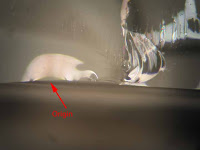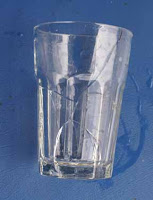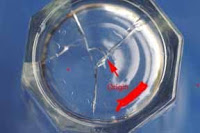


In order to simulate potential cracking of a heavy bottom drinking glass still hot from a commercial dishwasher, a glass was immersed in 140°F water till stabile. The glass was removed and ice water was then poured into the glass. A glass failure analysis expert witness then performed a failure analysis on the resulting cracked drinking glass. The drinking glass tested is not new; therefore, there is random handling damage present both inside and outside the tumbler. The upper left photo shows the overall cracking resulting from thermal shock. To the right is a photograph of the cracked bottom of the glass. The location of the crack origin is indicated. The crack started in the center of the bottom on the inside surface. When the ice water hit the hot interior bottom, it put the interior surface in tension, and this started the glass cracking. Upper right is a 25X photomicrograph of the crack origin. The failure began at a point where there is a small bruise. It is important to see that there is no major handling damage at this origin. This is because the failure was driven by thermal stresses not mechanical stresses. In addition, the initial part of the crack at the origin is not straight. The direction of the stresses are changing even when the crack is initiating.




